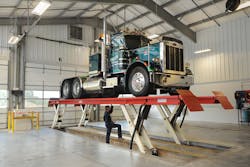A vehicle lift can be one of the most productivity-enhancing pieces of equipment in a shop. It can also be one of the most dangerous, especially if the wrong type of lift is being used or technicians are not using it properly.
There are several styles of lifts to choose from. Regardless of which style is purchased, several leading manufacturers agree that the ALI Gold Label is an essential feature to look for.
ALI is the Automotive Lift Institute. According to its president, R.W. “Bob” O’Gorman, one of the most important considerations from a safety perspective is whether or not the lift has been third-party tested and certified by ALI to meet the requirements of North America’s applicable electrical and mechanical safety standards.
“ALI recommends never buying an uncertified lift,” O’Gorman says. “After all, your safety is riding on it. Plus, in most of the U.S. and Canada, local building codes require that only certified lifts be installed. The International Building Code, which is in use or adopted by all 50 U.S. states, requires that all installed vehicle lifts conform with ANSI/ALI ALCTV.”
It is also important to note that ALI certification is a completely voluntary program. While many lifts from many leading manufacturers seek and attain the ALI Gold Label, not all do. Looking for that ALI stamp of approval is an important step in a fleet’s lift-buying research.
What type of lift do you need?
Paul Feldman, director of marketing for heavy duty lift manufacturer Stertil-Koni, says another important research step is to identify the parameters, requirements, and limitations of the maintenance facility. Shops should also think about the services being performed. Do technicians need access to the tires? How many vehicles will be lifted over the course of a day, and how heavy are those vehicles?
“There are many types of heavy duty vehicle lifts,” says Peter Bowers, technical sales support manager at Stertil-Koni.
Arguably the most popular in a fleet setting is the mobile column lift. Allister Collings, president of mobile column lift manufacturer SLEC, says fleets buy mobile lifts for two reasons. One is the portability factor. The other is under-vehicle access.
“The lift can be wheeled around the shop and used in any work bay — even outside should the need arise,” Collings says. “Then, accessibility is unobstructed because all lifting devices are under the tire, leaving everything else free.”
Once a user has decided to purchase a mobile column lift, Collings says there are two decisions that will guide the fleet in a particular direction, provided that cost isn’t the overriding factor.
“Fleets can choose hydraulic versus steel screw and bronze load nut, and wired versus wireless,” Collings says, adding that one is not necessarily better than the other. “A hydraulic lift is faster to raise and lower [approximately 94 seconds] which will appeal to some fleets. The self-locking screw lift is a bit more robust but will operate slower [approximately 150 seconds] for peace of mind. If the fleet is typically lifting two vehicles per day, the time saved is four minutes – no big deal.”
Wireless operation can be appealing because there are no cords to deal with, which also reduces a tripping hazard in the shop. However, fleets should remain cognizant of potential drawbacks to wireless operation, such as potential intermittent signal interruptions.
The mobile column lift is not the only lift type shops can benefit from. Other types include platform, swing-arm wheel-engaging two-post, and inground lifts in both low-depth scissor style and traditional vertical piston.
“Fleets need to think about what they are lifting, the weight of the vehicles they are lifting, any weight imbalance from front to rear, and the services their technicians will be providing while a vehicle is lifted,” Stertil-Koni’s Feldman says.
As an example, Feldman says a shop needing to perform quick oil changes can benefit from a lift they can drive a vehicle on and off of easily. A platform lift could be a good choice.
“A platform lift is also good for checking things like chassis and brakes for DOT inspections,” Stertil-Koni’s Bowers adds.
Technicians may also want wheels-free lifting to work on tires. Feldman says an in-ground piston lift or scissor lift can be a good choice because they engage the vehicle frame. For all of these reasons and more, Feldman says many facilities have more than one style of lift. It all depends on the unique needs of a given fleet.
Tips to ensure safe and proper lifting
Built-in safety locking mechanisms are an important lift feature shops should scrutinize. For instance, most of Stertil-Koni’s hydraulic lifts have a mechanical locking system.
“If something were to happen to the hydraulics, while rare, the lift will literally lock in place and become a stand,” Feldman points out. “When you listen to our lifts go up, you can hear the locks engaging. It’s the sound of steel on steel, and all of our customers talk about that sound. To us, it’s the prettiest sound there is because it’s the sound of safety. Mechanical locks also make an enormous difference in terms of the comfort level of a technician.”
Another sound best practice is to implement safeguards to ensure that only authorized technicians can operate a lift. Stertil-Koni has built-in safeguards where users need a key fob to activate a lift.
Speaking of technicians, proper and continual training is paramount.
“Sometimes technicians get into a groove and want to move a little bit quicker,” Stertil-Koni’s Bowers says. “It’s important to fight that temptation to cut corners.”
For example, Feldman says a good best practice is to raise a vehicle about 12” and then pause to conduct a walkaround and ensure that everything is stable.
“Every technician in the shop should be trained on the proper operation of each lift they will use,” ALI’s O’Gorman says. “This lift-specific training should be based on the lift manufacturer-provided instructions and warning labels, as well as the ALI publications, ‘Quick Reference Guide, Vehicle Lifting Points for Frame-Engaging Lifts, Safety Tips’ and the ANSI/ALI ALOIM [current edition] Standard for Automotive Lifts, ‘Safety Requirements for Operation, Inspection and Maintenance.’”
For general lift safety training, ALI has developed an online interactive training course entitled “Lifting It Right.” This course can be completed on a computer or mobile device in about an hour, in English or Spanish.
For an easy shop reminder of basic lift safety tips, ALI also offers an updated and expanded Automotive Lift Safety Tips Card and new Safety Tips Poster. Both feature 13 tips for safe lifting, including lift operation, maintenance, and inspection.
About the Author

Gregg Wartgow
Gregg Wartgow is a freelancer who Fleet Maintenance has relied upon for many years, writing about virtually any trucking topic. He lives in Brodhead, Wisconsin.
